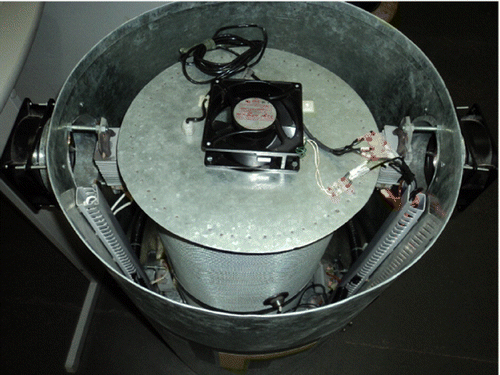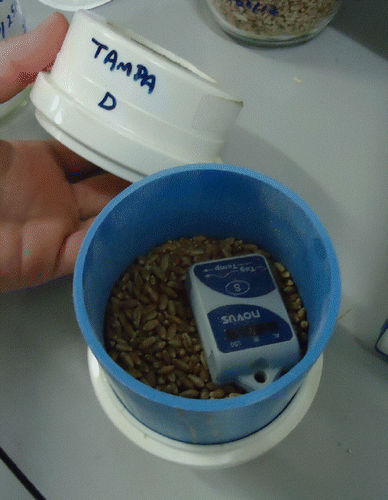 ?Mathematical formulae have been encoded as MathML and are displayed in this HTML version using MathJax in order to improve their display. Uncheck the box to turn MathJax off. This feature requires Javascript. Click on a formula to zoom.
?Mathematical formulae have been encoded as MathML and are displayed in this HTML version using MathJax in order to improve their display. Uncheck the box to turn MathJax off. This feature requires Javascript. Click on a formula to zoom.Abstract
The present study showed how the construction of a grain silo prototype can be used to increase the mortality rate of the lesser grain borer, Rhyzopertha dominica (F.). The silo prototype is a bin of small dimensions, adequate for laboratory environments, equipped with controlled temperature for the mass of wheat stored therein. Adjusting the temperature and the time of exposure in the bin may be an effective tool to eliminate R. dominica.
Public Interest Statement
The most aggressive insect that attacks wheat stored into silo bins is the Rhyzopertha dominica (F.) (Coleoptera, Bostrichidae). Some investigators evaluate a loss of 10
Competing Interests
The authors declare no competing interest.
Editors Comments
Editors Comments go here.
Non-Handling Editors Comments
Non-Handling Editors Comments go here.
1. Introduction
Some species of insects (e.g. lesser and larger grain borer) that attack the kernel of the grain find appropriate environmental conditions for intense reproduction (Faroni, Guedes, & Matioli, Citation2001; Kavallieratos, Athanassiou, Pashalidou, Andris, & Tomanovic, Citation2005; Lord, Citation2005; Singh, Jayas, Paliwal, & White, Citation2010). The presence of these insects weakens the quality of the stored grains and is responsible for an expressive amount of grain losses each year. To take one account, the Brazilian government estimated a grain harvest of 185 million tons at the 2012/2013 season, and of it may have become inadequate for consumption due to the action of insects (Lorini & Galley, Citation1999).
As an attempt to control the pests, farmers and storage managers have used different methods to reduce insect infestation. The most common control strategy is to use pesticide directly on the grains (Edde, Citation2012; Kaur, Daniels, Nayak, Ebert, & Schlipalius, Citation2013; Lorini, Collins, Daglish, Nayak, & Pavic, Citation2007; Lorini & Galley, Citation1999,Citation2000; Shi, Collins, Ridsdill-Smith, & Renton, Citation2012; Zettler & Cuperusi, Citation1990), but pesticide residues may cause health problems (Kaushik, Satya, & Naik, Citation2009) and may fail to control the infestation as already shown in Lorini (Citation2007) and Lorini and Galley (Citation1999). In fact, the authors of Lorini (Citation2007) and Lorini and Galley (Citation1999) affirm that the lesser grain borer Rhyzopertha dominica (F.) (Coleoptera, Bostrichidae), the most important pest of stored wheat in Brazil, exhibits a strong resistance to the pesticide phosphine. Such pesticide resistance demands alternative tools for suppressing the population of R. dominica in stored wheat. We contribute towards this direction by presenting a technology for constructing a pesticide-free grain silo prototype, as detailed next.
An efficient strategy for controlling the infestation of R. dominica in bulk grain is to heat it during a certain period of time (Beckett & Morton, Citation2003; Beckett, Morton, & Darby, Citation1998; Flinn & Hagstrum, Citation2011; Khamis et al., Citation2010). Heating does not generate toxic residues, so that it has clear advantages when compared with the pesticide-based ones. This motivated us to develop a technology to built up a novel grain silo prototype, a device with automatic controlled temperature. The equipment has small dimensions, which turns it appropriate to be used in laboratories. Besides, it is environmentally clean—it accomplishes the complete eradication of the infestation through controlled heat, as illustrated in Section 2.1.4.
The data presented in this study suggest that our equipment be efficient for suppressing the pest from bulk wheat infested by R. dominica. It seems to be a direct consequence of the automatic control of temperature inside the bulk grain; the temperature of the bulk can be adjusted according to the user’s decision. The details regarding the construction of the grain silo prototype and the results taken from experiments are described in the sequence.
2. Materials and methods
2.1. Grain silo prototype structure
The main structure of the grain silo prototype is made of galvanized steel, in a cylindrical format, having a cylindrical inner bin to store the grains (Figure ). The wall of the inner cylindrical shell is constructed with a screen mesh of metal to facilitate the air flow. The external prototype has dimensions of 750 mm in height and 400 mm in base diameter. The inner bin has dimensions of 680 mm in height and 300 mm in base diameter, which represents a storage capacity of 48 cubic decimeters of grain. In the practical experiments, 40 Kg of wheat was comfortably accommodated inside the bin.
A ventilating system was used to induce a uniform gradient of temperature within the grain silo prototype (Figure ). Namely, three fans of dimension mm each draw the cold air from the exterior environment and force its passage through the heating resistances.
Figure 2. Pictorial representation of the scheme used to implement the control of temperature in the grain silo prototype. Notes: The cold air flows through three distinct orifices and crosses the corresponding heating resistances. The hot air then acts on the wheat kernels stored in the inner bin, as indicated by the arrows, and the wheat becomes hotter just as the air becomes hotter. The sensors and
measure the instantaneous temperature directly from the bottom and middle of the mass of grains, respectively. The control strategy interprets this information to regulate appropriately the energy sent to the heat resistances. An orifice is dedicated to discard spurious impurities and hot air.
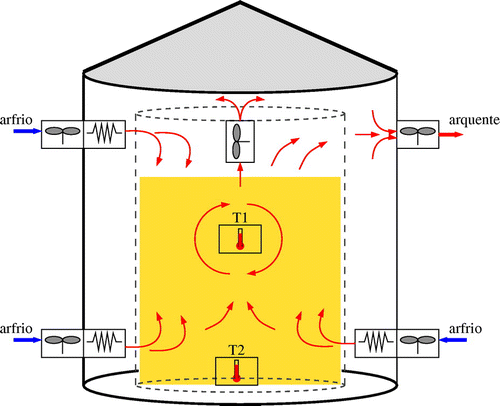
Figure 3. Picture of the laboratory testbed used in the experiments. Notes: The apparatus comprises the grain silo prototype that stored wheat infested by R. dominica, the electrical control panel that implemented the control of temperature inside the silo, and a computer that collected and saved all of the data corresponding to the experiments.
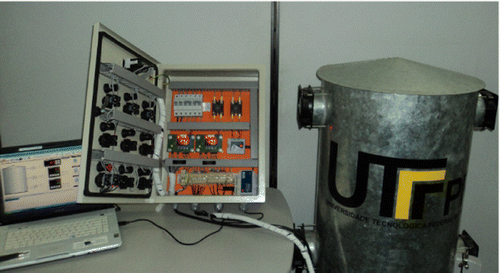
Just after crossing the resistances, the warmer air enters into the inner bin to act on the grains stored therein, whereas a fan attached in the top of the inner bin pushes part of the warmer air up. An additional fan makes the overall aeration of the main structure (see Thorpe (Citation1997) for an account on the importance of aeration). Three resistors of 1,200 Watts each were used to heat the air inside the bin.
2.1.1. Electrical control panel
An electrical control panel was constructed to implement the control of temperature inside the grain silo prototype (Figure ). The procedure for assembling this panel was as follows: two temperature measurement instruments, called PT100 thermocouples (Ricolfi & Scholz, Citation1990), were mounted into the grain silo prototype (c.f., and
in Figure ). These two sensors were connected with two independent feedback links that generate signals to be processed by two corresponding controllers located in the panel. The two controllers used in the experiments were made up by Novus Automation Inc., Brazil, model Novus N120, an industrial solution that implements the Proportional Integrative Derivative (PID) control strategy (Åström & Hägglund, Citation1995; Phillips & Harbor, Citation1996). These controllers regulated the amount of energy that some solid-state relays sent to the heating resistances.
2.1.2. Remarks on the feedback control system
Two sensors of temperature were used at different locations of the mass of grains. The first sensor was located at 10 cm from the ground, and the second one at 40 cm from the first. The respective controllers actuate to generate the necessary heat, in the sense that the involved thermal process of controlling the temperature inside the grain silo prototype is a two-input two-output control system. The control system has two independent reference inputs and two measured temperature outputs, and each control loop has its own PID controller.
Figure 4. Supervisory software screen. Note: The software collects and saves all of the data generated by the electrical control panel during the control of temperature.
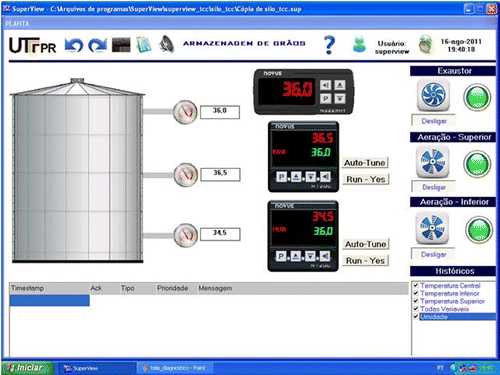
Heating effects in the bulk seem to follow a nonlinear behaviour—deriving a nonlinear model for representing the heating effects is not in the scope of this paper. For this reason, the PID control used in the experiments was model-independent. In this case, to tune the two PID controllers, we kept the same reference input for both controllers and followed the tuning strategy suggested by the Ziegler-Nichols method (Åström & Hägglund, Citation1995, Ch. 4.3). That method indicated the gains ,
, and
, which were used in practice in the PID controllers.
2.1.3. Supervisory software
A supervisory software was developed to monitor and store in any computer all the data generated by the electrical control panel (Figure ). The software can manage all the variables of the process; for instance, it can fix the temperature’s reference as well as the PID’s parameters. The electrical control panel can work independently of the software, in the sense that the temperature is controlled even if the supervisory software is off.
2.1.4. Insects and treatments
R. dominica samples were taken from a colony that has been maintained in a laboratory at the National Soybean Research Centre (Embrapa Soybean), Londrina, Paraná, Brazil. Forty-five jars with two hundred adult insects of R. dominica each were reared in wheat grain at the laboratory for 40 days. After that, the contents of each jar were delivered into a small tubular chamber, made from plastic PVC, and carefully sealed across the top and bottom with filter paper (see Figure ). This procedure allowed us to produce forty-five chambers, all of them used in the experiments.
A number of nine experiments were carried out, according to the next steps. Four chambers were selected, and they were placed in the silo bin filled with wheat—the chambers were stacked on top of one another with a distance of 15 cm between them. The chambers were labeled as A, B, C, and D, and were allocated in the bulk wheat from bottom to top, in this order. The distance from the ground of the bin to the bottom of the first chamber also respected 15 cm.
The wheat grains inside the bin were exposed to C for 24 h. During this period, other chamber served as the control treatment and was maintained outside the silo under restricted conditions (
C and
relative humidity). After 24 h, the used chambers were substituted by fresh chambers, and the process was then repeated for 72 h; and afterwards for 120 h.
The procedure was repeated for temperatures at 47.5 and C; in both cases, the time of evaluation was 24, 72, and 120 h. Nine experiments were undertaken in total, and forty-five chambers were used.
Table 1. Mortality assessment of R. dominica in a bulk wheat with control of temperature and the production of descendants () 60 days after the exposition
After completing every stage of the experiment, the contents of the chambers were taken out and the grain was sieved to separate and count the number of dead and alive adults of R. dominica. After that, the wheat grain with alive insects was returned to each jar and kept there for 60 days (under restricted conditions, i.e. C and
relative humidity). That amount of time was required to evaluate the offspring (
) generation of insects—again, the number of insects was determined. The resulting values were then recorded and used for statistical analysis, such as ANOVA; in particular, the mean was classified by the Tukey test (Freund & Wilson, Citation2003, p. 256).
Figure 6. Temperature of the wheat measured by the sensors located at the bottom and middle of the inner bin. The three figures from top to down correspond to the references at C,
C, and
C, respectively.
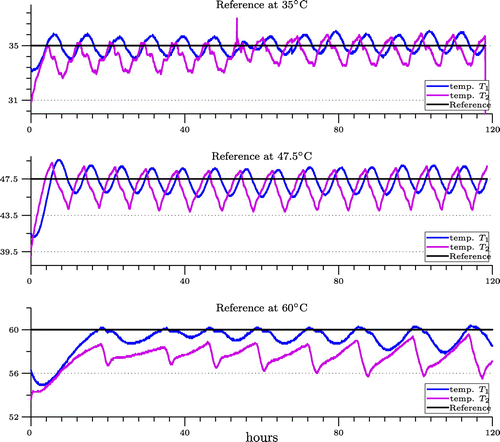
Figure 7. Temperature measured inside the chambers A, B, C, and D from three distinct experiments. Each experiment was undertaken over a period of 120 h. The chambers were inserted into the grain silo prototype with wheat, and the equipment was adjusted to regulate the temperature of the wheat at 35, 47.5, and C.
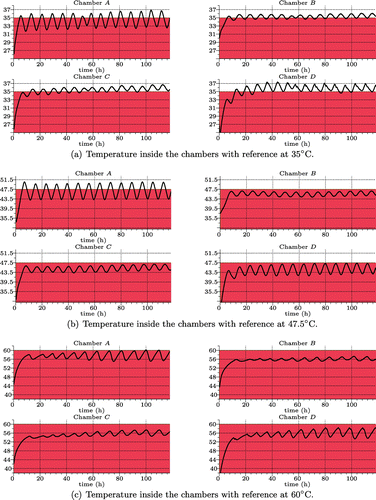
3. Results and discussion
The temperature measured by the two sensors and
are depicted in Figure . The figure suggests a periodic oscillation of the temperature in the wheat; this oscillation tends to be persistent. This fact indicates that the control process is second moment stable (Vargas & do Val, Citation2010). In addition, thermometer data loggers were used inside the chambers A, B, C, and D to measure the temperature therein, and the corresponding data is depicted in Figure . The curves in Figure indicate that the temperature in the chambers remained close to the reference values most of the time.
Table summarizes the experimental data obtained for the population of R. dominica. For instance, the first line of Table shows that the mean number of dead adults was 7.25 and of alive adults was 161—the difference of 31.75, necessary to complete the sample of 200 individuals, amounts to the quantity of insects hidden inside the wheat kernel.
The temperature is crucial to set the mortality of R. dominica. In fact, Table shows that the insect mortality was when the insects were exposed to heat at 47.5 and
C, in all exposure times, i.e. 24, 72, and 120 h, but
C at 24 h. Comparing this mortality result with the quantity of alive adults in the reference control group, we can conclude that the temperature increases the adult mortality of R. dominica. Besides, the population of R. dominica in wheat can disappear by adjusting both the temperature of the grain silo prototype and the time for which the prototype is programmed to work under that temperature.
Another result was the minimum offspring generation () observed at 47.5 and at
C (Table ); much more adults were generated in the
C case. This finding supports that higher temperatures induce higher insect elimination in the bulk grain, a conclusion in agreement with the results in the literature (e.g. Beckett & Morton, Citation2003; Beckett et al., Citation1998; Edde, Citation2012, Section 3.2; Faroni et al., Citation2001).
The experimental outcome signals that the control of temperature can be used positively as an efficient tool to diminish the population of R. dominica in bulk wheat. In particular, a complete suppression of the insects can be attained when the temperature is made higher.
4. Concluding remarks
We have presented the construction details of a grain silo prototype with automatic control of temperature. The practical functionality of such a prototype was verified by some experiments—interestingly, the experimental data suggested that the prototype be an efficient tool for suppressing the population of R. dominica, a common pest in stored wheat.
Our grain silo prototype was designed to produce heat from electricity, a suitable solution for small-scale laboratories. Instead of electricity, large-scale industrial silos may depend on other options of heat generators with a favorable cost per t for wheat, see the illustration in Beckett and Morton (Citation2003, Figure ). The positive benefits observed in our experiments suggest that the control of temperature can be a feasible tool for eliminating R. dominica from industrial grain silos.
Further research is necessary to assess the quality of the grains after exposed to the treatments—heat in long treatments may deteriorate the quality of the grains.
Additional information
Funding
Notes on contributors
Alessandro N. Vargas
Alessandro N. Vargas received the BS in Computer Engineering from the Universidade Federal do Espirito Santo in 2002 and MS and PhD degree in Electrical Engineering from the School of Electrical and Computer Engineering of the University of Campinas, Brazil, in 2004 and 2009, respectively. Since 2007, he has held a position of Control Systems professor at the Universidade Tecnologica Federal do Parana, Brazil. His research interests include stochastic systems and control with applications in electronics and electrical engineering.
References
- Åström, K. J., & Hägglund, T. (1995). PID controllers: Theory, design and tuning. Research Triangle Park, NC: Instrument Society of America.
- Beckett, S. J., & Morton, R. (2003). Mortality of Rhyzopertha dominica (F.) (Coleoptera: Bostrychidae) at grain temperatures ranging from 50°C to 60°C obtained at different rates of heating in a spouted bed. Journal of Stored Products Research, 39, 313–332.
- Beckett, S. J., Morton, R., & Darby, J. A. (1998). The mortality of Rhyzopertha dominica (F.) (Coleoptera: Bostrychidae) and Sitophilus oryzae (L.) (Coleoptera: Curculionidae) at moderate temperatures. Journal of Stored Products Research, 34, 363–376.
- Edde, P. A. (2012). A review of the biology and control of Rhyzopertha dominica (F.) the lesser grain borer. Journal of Stored Products Research, 48, 1–18.
- Faroni, L. R. D., Guedes, R. N. C., & Matioli, A. L. (2001). Effect of temperature on development and population growth of Acarophenax lacunatus (Cross & Krantz) (Prostigmata: Acarophenacidae) on Rhyzopertha dominica (F.) (Coleoptera: Bostrichidae). Biocontrol Science and Technology, 11, 5–12.
- Flinn, P. W., & Hagstrum, D. W. (2011). Movement of Rhyzopertha dominica in response to temperature gradients in stored wheat. Journal of Stored Products Research, 47, 407–410.
- Freund, R. J., & Wilson, W. J. (2003). Statistical methods (2nd ed.). San Diego, CA: Academic Press.
- Kaur, R., Daniels, E. V., Nayak, M. K., Ebert, P. R., & Schlipalius, D. I. (2013). Determining changes in the distribution and abundance of a Rhyzopertha dominica phosphine resistance allele in farm grain storages using a DNA marker. Pest Management Science, 69, 685–688.
- Kaushik, G., Satya, S., & Naik, S. N. (2009). Food processing a tool to pesticide residue dissipation - A review. Food Research International, 42, 26–40.
- Kavallieratos, N. G., Athanassiou, C., Pashalidou, F. G., Andris, N. S., & Tomanovic, Z. (2005). Influence of grain type on the insecticidal efficacy of two diatomaceous earth formulations against Rhyzopertha dominica (F) (Coleoptera: Bostrychidae). Pest Management Science, 61, 660–666.
- Khamis, M., Subramanyam, B., Flinn, P. W., Dogan, H., Jager, A., & Gwirtz, J. A. (2010). Susceptibility of various life stages of Rhyzopertha dominica (Coleoptera: Bostrichidae) to flameless catalytic infrared radiation. Journal of Economic Entomology, 103, 1508–1516.
- Lord, J. C. (2005). Low humidity, moderate temperature, and desiccant dust favor efficacy of Beauveria bassiana (Hyphomycetes: Moniliales) for the lesser grain borer, Rhyzopertha dominica (Coleoptera: Bruchidae). Biological Control, 34, 180–186.
- Lorini, I., Collins, P. J., Daglish, G. J., Nayak, M. K., & Pavic, H. (2007). Detection and characterisation of strong resistance to phosphine in Brazilian Rhyzopertha dominica (F.) (Coleoptera: Bostrychidae). Pest Management Science, 63, 358–364.
- Lorini, I., & Galley, D. J. (1999). Deltamethrin resistance in Rhyzopertha dominica (F.) (Coleoptera: Bostrichidae), a pest of stored grain in Brazil. Journal of Stored Products Research, 35, 37–45.
- Lorini, I., & Galley, D. J. (2000). Estimation of realized heritability of resistance to deltamethrin insecticide in selected strains of Rhyzopertha Dominica (F.) (Coleopetra: Bostrychidae). Journal of Stored Products Research, 36, 119–124.
- Phillips, C. L., & Harbor, R. D. (1996). Feedback control systems. 3rd. Englewood Cliffs, NJ: Prentice Hall.
- Ricolfi, T., & Scholz, J. (1990). Sensors, A comprehensive survey,Volume 4, thermal sensors. Hoboken, NJ: John Wiley & Sons .
- Shi, M., Collins, P. J., Ridsdill-Smith, J., & Renton, M. (2012). Individual-based modelling of the efficacy of fumigation tactics to control lesser grain borer (Rhyzopertha dominica) in stored grain. Journal of Stored Products Research, 51, 23–32.
- Singh, C. B., Jayas, D. S., Paliwal, J., & White, N. D. G. (2010). Identification of insect-damaged wheat kernels using short-wave near-infrared hyperspectral and digital colour imaging. Computers and Electronics in Agriculture, 73, 118–125.
- Thorpe, G. R. (1997). Modelling ecosystems in ventilated conical bottomed farm grain silos. Ecological Modelling, 94, 255–286.
- Vargas, A. N., & do Val , J. B. R. (2010). Average cost and stability of time-varying linear systems. IEEE Transactions on Automatic Control, 55, 714–720.
- Zettler, L. J., & Cuperusi, W. G. (1990). Pesticide resistance in Tribolium castaneum (Coleoptera: Tenebrionidae) and Rhyzopertha dominica (Coleoptera: Bostrichidae) in wheat. Journal of Economic Entomology, 83, 1677–1681.

